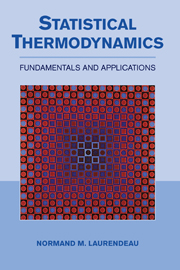Book contents
- Frontmatter
- Contents
- Preface
- 1 Introduction
- PART ONE FUNDAMENTALS OF STATISTICAL THERMODYNAMICS
- 2 Probability and Statistics
- Problem Set I Probability Theory and Statistical Mathematics (Chapter 2)
- 3 The Statistics of Independent Particles
- 4 Thermodynamic Properties in the Dilute Limit
- Problem Set II Statistical Modeling for Thermodynamics (Chapters 3–4)
- PART TWO QUANTUM MECHANICS AND SPECTROSCOPY
- PART THREE STATISTICAL THERMODYNAMICS IN THE DILUTE LIMIT
- PART FOUR STATISTICAL THERMODYNAMICS BEYOND THE DILUTE LIMIT
- PART FIVE NONEQUILIBRIUM STATISTICAL THERMODYNAMICS
- PART SIX THE ENSEMBLE METHOD OF STATISTICAL THERMODYNAMICS
- PART SEVEN APPENDICES
- Index
3 - The Statistics of Independent Particles
Published online by Cambridge University Press: 05 June 2012
- Frontmatter
- Contents
- Preface
- 1 Introduction
- PART ONE FUNDAMENTALS OF STATISTICAL THERMODYNAMICS
- 2 Probability and Statistics
- Problem Set I Probability Theory and Statistical Mathematics (Chapter 2)
- 3 The Statistics of Independent Particles
- 4 Thermodynamic Properties in the Dilute Limit
- Problem Set II Statistical Modeling for Thermodynamics (Chapters 3–4)
- PART TWO QUANTUM MECHANICS AND SPECTROSCOPY
- PART THREE STATISTICAL THERMODYNAMICS IN THE DILUTE LIMIT
- PART FOUR STATISTICAL THERMODYNAMICS BEYOND THE DILUTE LIMIT
- PART FIVE NONEQUILIBRIUM STATISTICAL THERMODYNAMICS
- PART SIX THE ENSEMBLE METHOD OF STATISTICAL THERMODYNAMICS
- PART SEVEN APPENDICES
- Index
Summary
Now that we have reviewed the essentials of probability and statistics, we are mathematically prepared to pursue our primary goal, which is to understand at a basic statistical level the fundamental laws and relations of classical thermodynamics. To avoid unnecessary complications, we will begin by evaluating the macroscopic properties of simple compressible systems composed of independent particles. The most important thermodynamic systems of this type are those describing the behavior of ideal gases. Recall that all gases behave as independent particles at sufficiently low density because of their weak intermolecular interactions combined with their extremely short-range intermolecular potentials. Such gaseous systems constitute a propitious place to begin our study of statistical thermodynamics because by invoking the assumption of independent particles, our upcoming statistical analyses can be based rather straightforwardly on probability theory describing independent events, as summarized in Chapter 2.
While considering assemblies of independent particles, we will pursue new insight with respect to three basic concepts important to classical thermodynamics. First, we will seek a whole new statistical understanding of entropy. Second, we will develop a related statistical definition of thermodynamic equilibrium. Third, in so doing, we will gain new perspective concerning the significance of temperature in properly defining thermal equilibrium. Once we understand these three major concepts, we will be in a position to develop statistical expressions allowing us to evaluate the thermodynamic properties of an assembly from the quantum mechanical properties of its individual particles.
- Type
- Chapter
- Information
- Statistical ThermodynamicsFundamentals and Applications, pp. 29 - 44Publisher: Cambridge University PressPrint publication year: 2005



